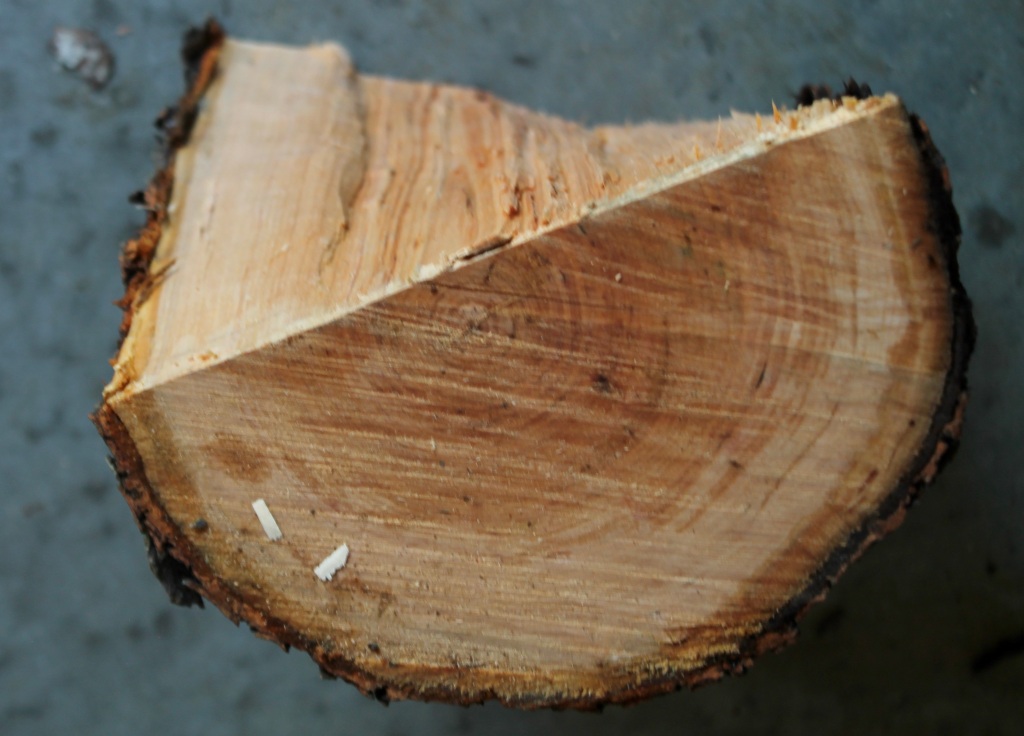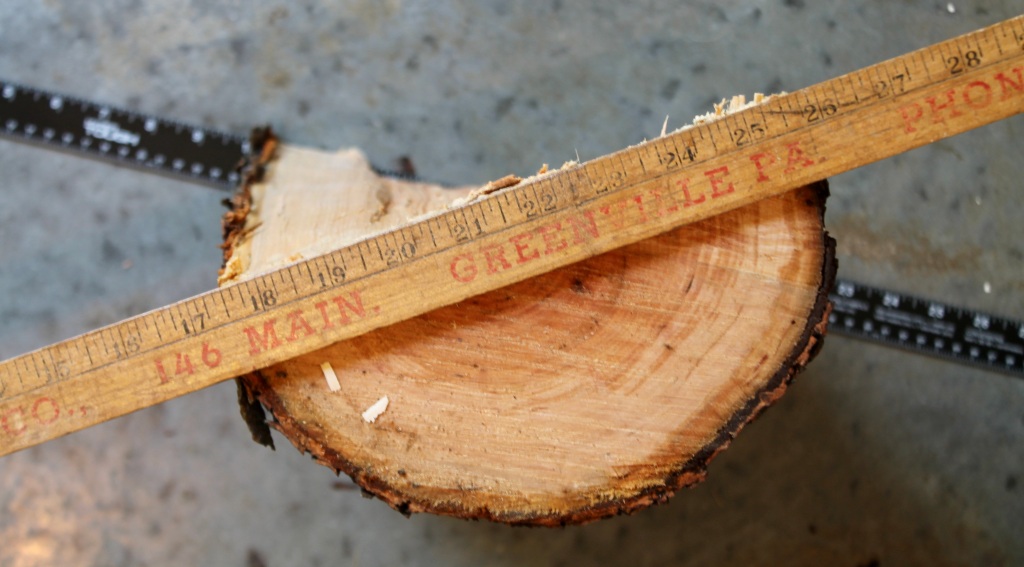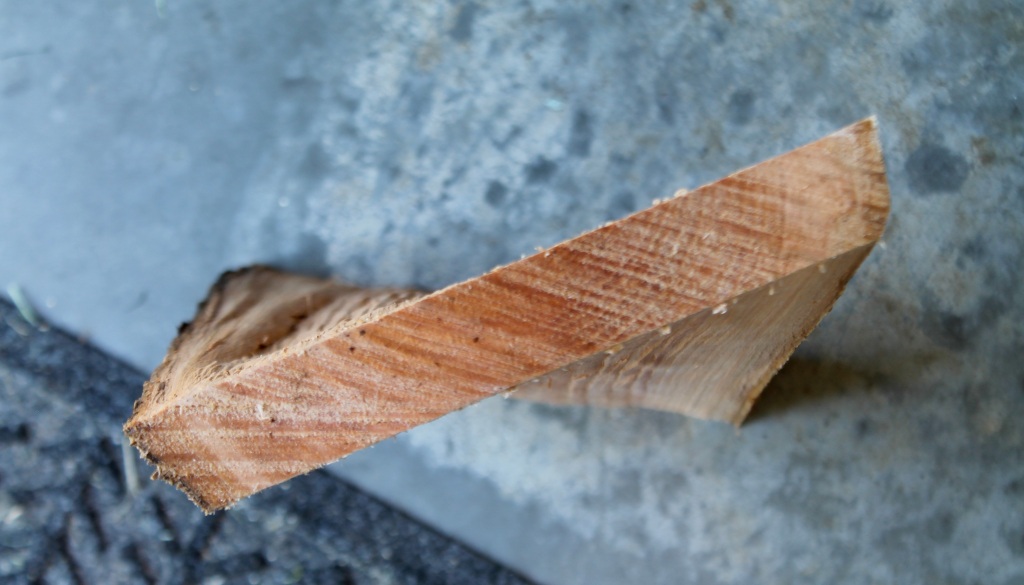
Yesterday, I was splitting a small straight cherry log for a potential bowl. I was planning on using the upper half above this chunk. As the log split apart, my plans changed.

Just about every tree grows with at least a small amount of twist, but this is beyond the average. In the photo above, I’ve put a yard stick on the straight edge of the split at both ends of this 15″ log. The log twists about 30 degrees in that short length. At that rate, the twist would wrap 360 degrees, all the way around the trunk, in a length of just over 16 feet.
I wouldn’t have noticed this at all had I just cut the log into two halves with a chainsaw, but I would have noticed it as I began to carve the bowl. The flow of the grain is far from what was expected and a chunk of the bowl splits away in front of your drawknife. And even if you successfully tackle the twist of the fibers, things can change during the drying process. I have had bowls sort of “unwind” a bit as they dry when carved from a dramatically twisted blank. A bowl carved straight ends up with some wind from end to end. As I mentioned, a little bit of twist in a log is no big deal, and usually unavoidable. But I reject one like this.
Chairmakers have to pay particularly close attention to the flow of the fibers through narrow chair components. Peter Galbert has a great article on understanding grain and the effect of twist hidden within straight boards in the April 2024 Issue (#309) of Fine Woodworking Magazine. He has also tackled the subject in his Substack blog, including video.
Speaking of Pete, I’m looking forward to my August trip to his shop for the bowl carving course. That one is full; a big thanks to all who have signed up. So, we’re planning to do it again October 7-12. Here’s the link. Registration opens tomorrow (Wednesday) morning at 8:00 am EST.
And what to do with my twisted log…

I was getting ready to chuck it onto the firewood stack, but then I went at it with the froe. That’s one of the boards I split out above. Imagine how much trouble it would be to saw a board like that. I’ve stacked a few to dry in the shed. Twist may just the thing I’m looking for in some future project.

I hope so and if you do use the
twist give us a shout–
LikeLiked by 2 people
Perfect, Marie! Will do.
LikeLike
Perhaps an ergonomic spoon blank or two, David?
If the bowl is twisted a little it may actually be more comfortable to use…
Either way, I imagine you will make something great.
LikeLiked by 1 person
I like that idea, Russ. Thanks. I’ve done that to some degree (by accident) and have been happily surprised by how comfortable it can be to use — for a righty or a lefty, but not both. You can’t please everyone!
LikeLike
:(. Yes, I very often encounter twists, that’s a bad one 😀
Sometimes I plane a shallow twist flat but would also reject that one! Also I usually split my blanks, using a froe and wedges – a little more physical effort than a chainsaw perhaps but less hassle and probably safer, and much quieter*. It is also free exercise and skills learning :).
BTW I occasionally use a pair of old “winding sticks” to judge twist for finer woodworking, to guide my planing efforts.
*I live in the countryside but it has become so noisy these days, most commonly due to various (most often Stihl) motor tools (blowers, chainsaws, strimmers/weedwackers, lawn mowers, garden tractors, etc.). I’m making the move back to hand-tools and battery tools. My Oregon battery chainsaw is very good, quieter and less hassle (e.g. built in sharpener, no petrol or 2-stroke oil). Ditto hedge-trimmer & weedwacker. Honourable mention to my beloved hand-tools, such as my old reap hooks, axes, bill hooks, adzes, froes, wedges, mallets/hammers and various bow saws. 🙂
LikeLiked by 1 person
Yes, winding sticks can reveal even the slightest twist/wind. Wonderful things. Mine are just a couple scrap pieces of “stop moulding.” No winding sticks required for this one!
LikeLike
I got my winding sticks cheap at Weyhill carboot sale. The seller, a lovely old chap, always had a lot of tools sell so sold them cheap. He was impressed/surprised that I even knew what they were 😀 let alone bought them! 50p I think, too cheap to not get/save. Probably somebody’s old apprentice piece? Nice, old, with 2 tones of wood to help functionality. 🙂
On another visit, to the same chap, I put together a nice, full set of long, vintage English firmer chisels from his various buckets of tools. He offered me a very good price (can’t recall if it was £1 each or 50p each now). Regrettably I turned his generous offer down 😦 , as I had recently decided I already had enough chisels to last a lifetime and then some. I use Lidl’s cheap but good German, wooden handled, bevel edge chisels, as recommended by Paul Sellers (Lidl and Aldi stopped carrying them last I heard 😦 ), as my main working chisels but I also have various vintage chisels (inc. wide ones) and old beater chisels plus 2 sets of cheap modern/far Eastern chisels! Hopefully I can pass some of them on one day!
LikeLike
If you ever need to make a large auger screw or propeller, I think you have found the proper wood. It is kind of cool how much twist there is in it.
LikeLiked by 1 person
Great idea, Joe! And I may have to build an airplane to go with it.
LikeLike
Maybe good for a cool-looking spoons or spatulas with twisted handles for right or left handed people? I’ve sometimes done that with interesting results.
LikeLiked by 1 person
Now I’m really thinking about this more, Jim. Thanks for sharing the idea and your experience.
LikeLike
My first thought was “that’s a propeller just waiting to escape from the tree.”
LikeLiked by 1 person
I see an interesting twisted box in your future, twisted dovetail corners, twisted lid, twisted…..
LikeLiked by 1 person
Actually I rarely use a plane when making bowls
Normally I use an axe (my very broad old French hewing axe is very good for this, or my lovely Gransfors Bruks Wille Sunqvist-style carving axe), and/or a drawknife, and/or a spokeshave; using my homemade Drew Langsner/Swiss-style dumb-head shave horse. 🙂
LikeLike